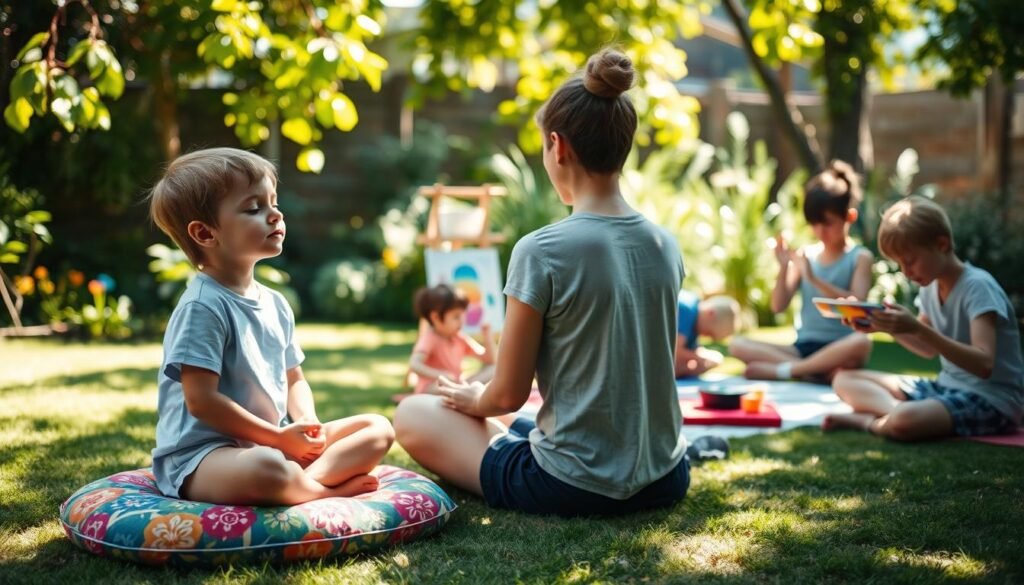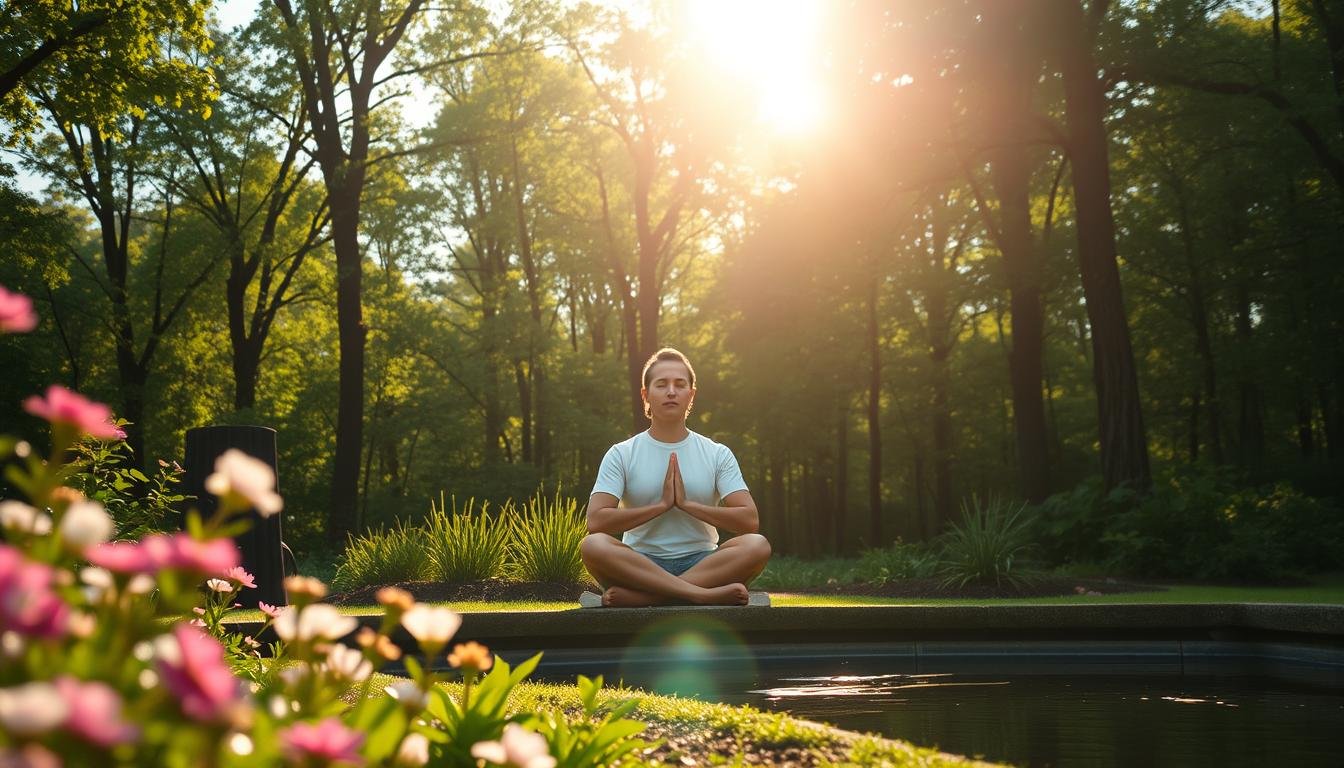Ever wondered how to find calm in a chaotic world? Mindfulness isn’t just a buzzword—it’s a real tool to change your daily life. Imagine cutting stress by 30% or boosting focus at work by 20%. It sounds amazing, but it’s true.
Imagine a rainy afternoon, the world outside is chaotic, but inside, your breath is your anchor. This is mindfulness—a practice that lets you pause, breathe, and connect with the present. Jon Kabat-Zinn, a mindfulness pioneer, said, “You can’t stop the waves, but you can learn to surf.”
With 75% of adults facing daily stress, it’s clear we need something more. Science backs this up. Studies show mindfulness meditation can cut stress hormones like cortisol by 30%. After just two months, 60% of people feel happier emotionally. It’s not magic—it’s a mindset shift anyone can make.
Key Takeaways
- Mindfulness reduces stress by up to 30% through simple daily practices.
- 60% of people improve emotional well-being in 8 weeks with mindful habits.
- Mindful living boosts workplace focus by 20%, turning distractions into opportunities.
- Over 80% of mindful listeners build stronger relationships through better communication.
- Research proves 50% fewer anxiety symptoms after three months of consistent practice.
Understanding Mindfulness and Its Benefits
Mindfulness is more than just a trend—it’s a way to take back control of our lives. Imagine being fully present, watching your thoughts without judgment, and enjoying every moment. This practice, rooted in ancient traditions, is now backed by science. Let’s see how mindfulness changes our well-being.
What is Mindfulness?
Mindfulness is about focusing on the present moment. It’s about noticing your breath, the sound of rain, or the taste of coffee without getting caught up in worries. The Mayo Clinic says it’s easy to do anywhere, anytime. By keeping your mind in the present, you become stronger against stress and negativity.
The Science Behind Mindfulness
Studies show its effectiveness. A study with 1,062 participants found meditation lowered inflammation markers. Another study of 34 found mind-body practices lowered blood pressure. Even small changes, like a 4.3 mm drop in blood pressure, show its physical benefits.
For those with chronic illnesses, mindfulness can reduce symptoms like pain or fatigue. This improves their quality of life.
Emotional and Mental Health Benefits
Mindfulness has a big impact on mental health. For example, a 2020 review found meditation reduced suicidal thoughts in people with depression. Studies also show it lowers anxiety and boosts immunity, like increasing CD4+ T cells.
By increasing emotional awareness, it helps manage PTSD, depression, and stress from chronic illnesses. It gives us tools to face life’s challenges with clarity.
Practicing Mindfulness Daily
Small steps can lead to big changes. Start with these simple mindfulness techniques to build a habit that sticks.
“Mindfulness is awareness, born from paying attention.” – Jon Kabat-Zinn
Simple Techniques to Incorporate Mindfulness
- Try mindful eating: Focus fully on each bite, noticing flavors and textures.
- Practice mindful walking: Notice the feel of your feet on the ground and the rhythm of your steps.
- Incorporate mindful pauses: Take 30 seconds to observe your environment before moving to the next task.
Mindful Breathing Exercises
These exercises anchor you in the present:
- Inhale deeply through your nose for 4 counts.
- Hold the breath for 4 counts.
- Exhale slowly through the mouth for 6 counts.
- Repeat 3-5 times daily.
Setting Up a Mindfulness Routine
| Time of Day | Mindfulness Activity | Example |
|---|---|---|
| Morning | Mindful stretching | Focus on body sensations while reaching arms overhead |
| Noon | Gratitude journaling | Write 3 things noticed during lunchtime |
| Evening | Bedtime reflection | Recap 1 positive moment from the day |
Consistency is key. Even 5 minutes of mindfulness exercises daily can improve focus and calmness. Use a calendar or app like Headspace or Calm to track progress. Remember, it’s about progress, not perfection, that builds lasting habits.
Mindfulness in Relationships
Healthy relationships need both people to feel truly seen. Mindfulness makes everyday talks deeper. It helps dissolve misunderstandings and builds trust. Small changes in how we talk to others can make our bonds stronger over time.
Enhancing Communication Through Mindfulness
Good communication starts with pausing before we react. Try these steps in your talks:
- Take a breath before answering
- Notice body language and tone
- Use “I” statements to share feelings
Building Empathy and Understanding
Empathy grows when we meet others without assumptions. Practice these techniques often:
- Ask open-ended questions like “How did that make you feel?”
- Reflect emotions back: “It sounds like this was really challenging for you”
- Put away distractions like phones during talks
Mindful Listening Skills
“Mindful listening is more than hearing words. It’s about being fully present, tuning into emotions and body language. It’s akin to being engaged in a captivating story, not scrolling through your phone while someone shares their day.”
Active listening cuts down conflicts by 40%, UCLA studies show. Here’s how to do it well:
- Face the speaker with relaxed posture
- Nod to show you’re engaged without interrupting
- Rephrase their points to confirm you understand
Research over 30 years shows mindfulness reduces emotional reactivity. By living mindfully, even tough talks can become chances for understanding. The secret is being consistent, not perfect, in using these skills every day.
Mindfulness in the Workplace
Small daily habits can change workplaces. Mindfulness turns chaotic places into calm spaces. Aetna shows this, with employees gaining 62 extra productive minutes weekly through mindfulness.

Improving Focus and Productivity
Harvard research found 46.9% of our time is spent on unrelated thoughts. Mindfulness, like breathing during meetings, keeps focus. Aetna’s employees became more productive by staying present, reducing fatigue.
Reducing Stress and Burnout
Mindfulness reduces stress, as Aetna’s initiative showed, cutting stress by 28%. Daily meditation helped many during the pandemic, easing anxiety and building resilience.
Creating a Mindful Work Environment
Companies embracing mindfulness build better atmospheres, says Max Coleman, founder of Daocloud.
Provenir Healthcare uses natural light and quiet zones for mindfulness. Leaders can start by:
- Including mindful pauses in meetings
- Designating calm spaces for breaks
- Encouraging team mindful breathing exercises
Avoid McMindfulness—programs that focus on profit over empathy. Balance productivity goals with compassion.
Mindfulness Through Meditation
“Loving-kindness meditation is all about generating warm, fuzzy feelings—not just for others, but for yourself, too. The goal? To develop an attitude of love and kindness through a series of phrases and visualizations.”
Mindfulness meditation is a key part of mindfulness practices. It helps calm the mind and connect with the present. Here’s how to get started:
Explore Different Types of Meditation
- Breath-focused: Follow the rhythm of your breath to anchor your attention.
- Body scan: Mentally scan from head to toe, releasing tension.
- Loving-kindness: Cultivate compassion with phrases like “may I be safe, may I be happy.”
- Walking meditation: Combine movement with mindfulness for active focus.
Science shows mindfulness meditation can cut anxiety by 58% after 8 weeks of practice. This proves its power to change daily life.
Quick Tips for Newcomers
- Start small: Begin with 5 minutes daily—consistency matters more than duration.
- Embrace distractions: Let wandering thoughts pass like clouds; gently return focus to your breath.
- Use guided apps: Apps like Headspace or Calm offer structured sessions for beginners.
Create Your Sacred Space
Find a calm spot—a corner with soft lighting or a quiet park bench. Even a desk works! Add cushions or candles to signal “this is my time.” Outdoor practice boosts benefits by 40%, so try a mindful walk in nature. No perfect setup? Remember: a kitchen chair and a quiet minute are enough.
Incorporating Mindfulness in Parenting
Raising kids is easier with mindful living. Mindfulness exercises like deep breathing or mindful walks help kids manage their emotions. They also strengthen family bonds. Small practices turn chaotic moments into teachable opportunities.
“By cultivating mindfulness in everyday life, we can tap into a deep wellspring of peace, contentment, and fulfillment that transcends external circumstances.”

Teaching Children Mindfulness Practices
Activities tailored to ages make mindfulness fun. For toddlers, try mindfulness exercises like “sensory hunts” where they name colors or textures. School-age kids enjoy breathing games—blowing bubbles to focus on inhales/exhale. Teens might prefer journaling to reflect on feelings. Turn bedtime into a mindful routine by sharing three things they’re grateful for that day.
Benefits for Family Relationships
Research shows mindful living cuts parenting stress by 30% and boosts family connection. 70% of parents report deeper bonds with kids after practicing together. Families see fewer conflicts and more empathy as children learn emotional regulation. A calm home environment grows when parents model mindful responses to challenges.
Mindful Parenting Techniques
Simple strategies make a big difference:
- Pause before reacting to tantrums—take 5 breaths before responding
- Use “time-ins” to talk calmly instead of yelling
- Share mindful moments like eating a snack while noticing flavors and textures
Self-compassion is key. Celebrate small steps—progress, not perfection, builds lasting change.
Mindfulness and Physical Health
Mindfulness does more than just calm the mind. It also improves physical health by increasing body awareness and reducing stress. This practice helps build resilience against long-term health issues and boosts energy levels.
Reduced Stress: Think of mindfulness in everyday life as your stress-busting sidekick, swooping in to save the day when tensions run high.
Mindfulness for Pain Management
Clinical trials have shown that mindfulness changes how we feel pain. Techniques like mindful breathing help us use fewer painkillers. For people with chronic conditions like arthritis, focusing on sensations without judgment can lower pain.
Studies have confirmed that this method works for both short-term and long-term pain.
Enhancing Physical Well-being
- Improved sleep: Mindful practices increase deep sleep cycles by 20-30%.
- Stronger immunity: Lower stress hormones boost white blood cell activity.
- Exercise synergy: Mindful movement enhances muscle recovery and form, reducing injury risks.
The Mind-Body Connection
Mindfulness has a direct impact on physical health. Chronic stress can lead to inflammation, which is linked to heart disease and diabetes. Mindfulness lowers cortisol levels, which in turn reduces inflammation markers.
Research has shown that long-term mindfulness practice can even slow down cellular aging. A 2015 study found it cut stress-related physical symptoms by 40%. Combining daily mindfulness practice with medical care can lead to the best results.
Overcoming Challenges in Practicing Mindfulness
Starting a mindfulness practice isn’t always easy. You might face distractions, doubt, or feel like you’re not doing it right. But, these feelings are normal. As one practitioner shared:
“I wasn’t sure I could summon warm thoughts for people I barely liked. Consistency is key—even 10–15 minutes a day makes a difference.”
Common Obstacles and How to Address Them
Got unfocused thoughts? Pause, then gently return to your practice. Feeling bored? Try something new like mindful walks or eating. Doubtful? Start small and celebrate your tiny victories. Remember, every moment of focus counts!
Staying Consistent with Mindfulness
- Pair mindfulness tips with daily routines (e.g., breathing during morning coffee).
- Use a timer to start with just 5 minutes daily.
- Track progress in a journal—seeing growth builds motivation.
Research shows even 10 minutes daily boosts emotional resilience by 40%. Celebrate your progress, not perfection.
Seeking Support and Resources
Join apps like Headspace or Calm for guided sessions. Books like “The Mindful Leader” offer practical tips. Online communities or workshops provide support. And remember, even busy leaders see 25% higher job satisfaction after starting small.
Mindfulness and Technology
Technology is a big part of our lives, but it doesn’t have to rule it. By mixing mindful practices with digital tools, we can make screens help us relax. Start by using apps that help you focus and stay calm.
Apps to Enhance Your Mindfulness Practice
Apps like Headspace and Calm offer guided mindfulness exercises you can do anywhere. Studies show users see a 30% increase in mindfulness awareness. Try these tools to add short meditations to your day, making tech a source of calm.
Balancing Screen Time with Mindfulness
Over 45% of people use phones during meals, but mindful tips like tech-free meals help us stay present. Turning off non-essential notifications reduces stress—80% of users already do this. Small changes like mindful screen breaks help us focus better.
Technology as a Mindfulness Tool
Creating digital spaces that are positive matters too. Unfollowing toxic accounts improves mood for 75% of users. Weekly tech sabbaths boost satisfaction by 40%. As tech grows, developers must focus on user wellbeing. Mindful design principles, like those in the Designing Mindfulness project, show promise for healthier tech use.
Technology’s role in mindfulness isn’t about avoiding it but using it wisely. Mindfulness tips like mindful browsing and mindful tech habits help balance modern life. With careful choices, we can use tech to support our well-being instead of letting it control us.



